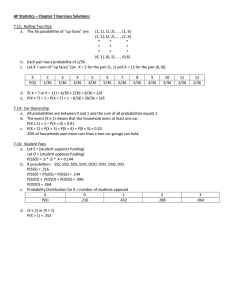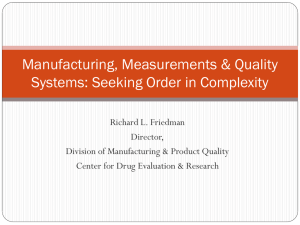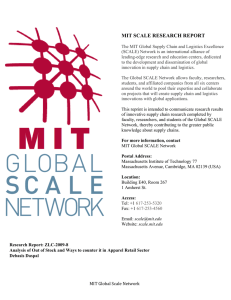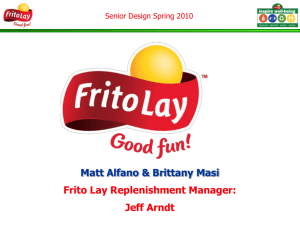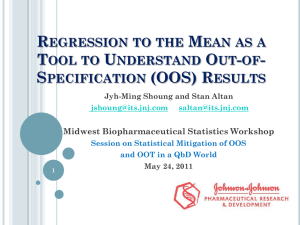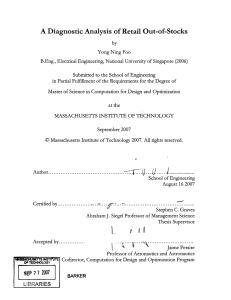Multi-Attribute Tradespace Exploration as an Enabler
advertisement
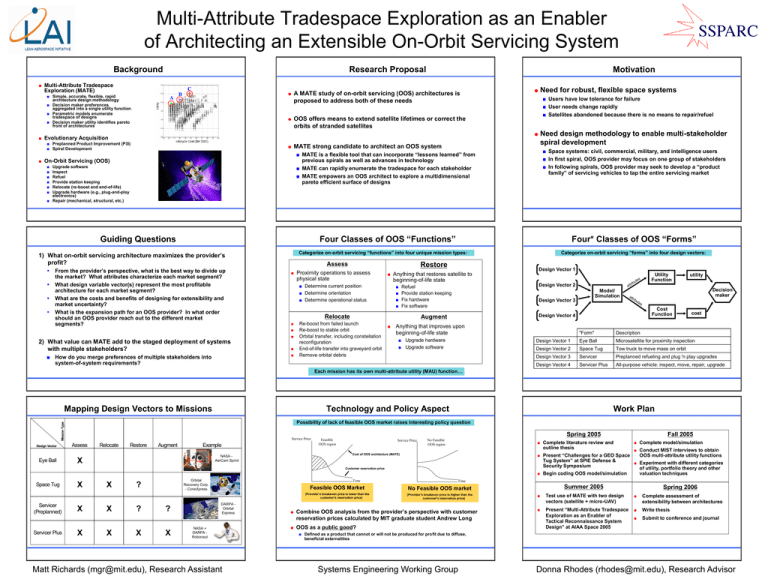
Multi-Attribute Tradespace Exploration as an Enabler of Architecting an Extensible On-Orbit Servicing System Background Multi-Attribute Tradespace Exploration (MATE) Research Proposal A MATE study of on-orbit servicing (OOS) architectures is proposed to address both of these needs Simple, accurate, flexible, rapid architecture design methodology Decision maker preferences aggregated into a single utility function Parametric models enumerate tradespace of designs Decision maker utility identifies pareto front of architectures Preplanned Product Improvement (P3I) Spiral Development Upgrade software Inspect Refuel Provide station keeping Relocate (re-boost and end-of-life) Upgrade hardware (e.g., plug-and-play electronics) Repair (mechanical, structural, etc.) § § From the provider’s perspective, what is the best way to divide up the market? What attributes characterize each market segment? What design variable vector(s) represent the most profitable architecture for each market segment? What are the costs and benefits of designing for extensibility and market uncertainty? What is the expansion path for an OOS provider? In what order should an OOS provider reach out to the different market segments? 2) What value can MATE add to the staged deployment of systems with multiple stakeholders? How do you merge preferences of multiple stakeholders into system-of-system requirements? Four* Classes of OOS “Forms” Categorize on-orbit servicing “functions” into four unique mission types: Restore Assess Proximity operations to assess physical state Determine current position Determine orientation Determine operational status Anything that restores satellite to beginning-of-life state Refuel Provide station keeping Fix hardware Fix software Relocate Space systems: civil, commercial, military, and intelligence users In first spiral, OOS provider may focus on one group of stakeholders In following spirals, OOS provider may seek to develop a “product family” of servicing vehicles to tap the entire servicing market Four Classes of OOS “Functions” 1) What on-orbit servicing architecture maximizes the provider’s profit? § MATE is a flexible tool that can incorporate “lessons learned” from previous spirals as well as advances in technology MATE can rapidly enumerate the tradespace for each stakeholder MATE empowers an OOS architect to explore a multidimensional pareto efficient surface of designs Users have low tolerance for failure User needs change rapidly Satellites abandoned because there is no means to repair/refuel Need design methodology to enable multi-stakeholder spiral development MATE strong candidate to architect an OOS system Guiding Questions § On-Orbit Servicing (OOS) OOS offers means to extend satellite lifetimes or correct the orbits of stranded satellites Need for robust, flexible space systems Evolutionary Acquisition Motivation Design Vector 1 Design Vector 2 u rib t t a tes at t rib u Upgrade hardware Upgrade software Utility Function utility Decision maker tes Cost Function Design Vector 4 Anything that improves upon beginning-of-life state Model/ Simulation Design Vector 3 Augment Re-boost from failed launch Re-boost to stable orbit Orbital transfer, including constellation reconfiguration End-of-life transfer into graveyard orbit Remove orbital debris Categorize on-orbit servicing “forms” into four design vectors: cost "Form" Description Design Vector 1 Eye Ball Microsatellite for proximity inspection Design Vector 2 Space Tug Tow truck to move mass on orbit Design Vector 3 Servicer Preplanned refueling and plug 'n play upgrades Design Vector 4 Servicer Plus All-purpose vehicle: inspect, move, repair, upgrade Each mission has its own multi-attribute utility (MAU) function… Mapping Design Vectors to Missions Technology and Policy Aspect Possibility of lack of feasible OOS market raises interesting policy question Mission Type Design Vector Eye Ball Work Plan Service Price Assess Relocate Restore Augment Example Feasible OOS region Service Price No Feasible OOS region Cost of OOS architecture (MATE) NASA AerCam Sprint X Spring 2005 Customer reservation price Space Tug Servicer (Preplanned) Servicer Plus X X X X X X Orbital Recovery Corp. - ConeXpress ? ? X DARPA Orbital Express ? X Time NASA + DARPA Robonaut Matt Richards (mgr@mit.edu), Research Assistant Present “Challenges for a GEO Space Tug System” at SPIE Defense & Security Symposium Complete model/simulation Conduct MIST interviews to obtain OOS multi-attribute utility functions Begin coding OOS model/simulation Experiment with different categories of utility, portfolio theory and other valuation techniques Summer 2005 Spring 2006 Time Feasible OOS Market No Feasible OOS market (Provider’s breakeven price is lower than the customer’s reservation price) (Provider’s breakeven price is higher than the customer’s reservation price) Combine OOS analysis from the provider’s perspective with customer reservation prices calculated by MIT graduate student Andrew Long OOS as a public good? Complete literature review and outline thesis Fall 2005 Test use of MATE with two design vectors (satellite + micro-UAV) Present “Multi-Attribute Tradespace Exploration as an Enabler of Tactical Reconnaissance System Design” at AIAA Space 2005 Complete assessment of extensibility between architectures Write thesis Submit to conference and journal Defined as a product that cannot or will not be produced for profit due to diffuse, beneficial externalities Systems Engineering Working Group Donna Rhodes (rhodes@mit.edu), Research Advisor
